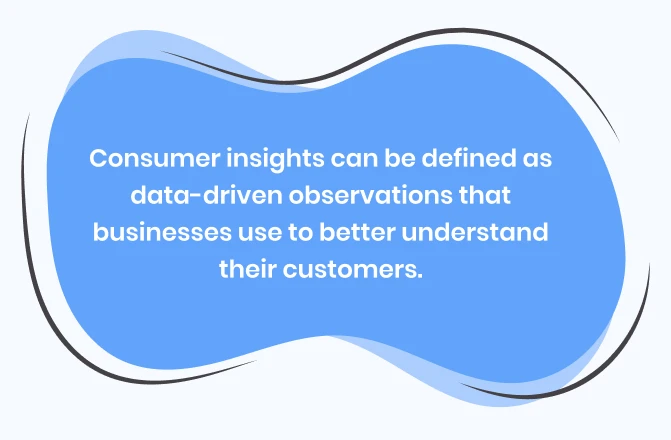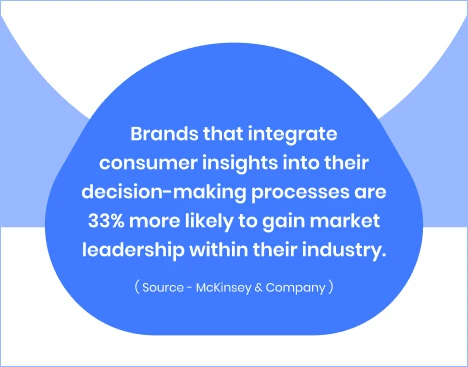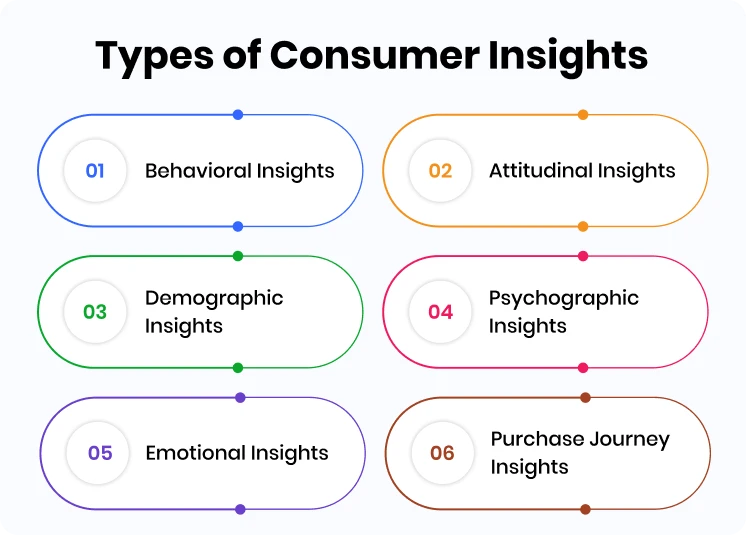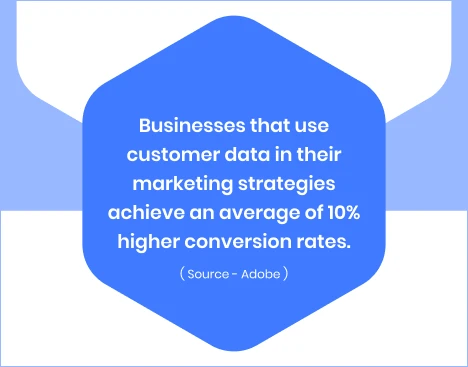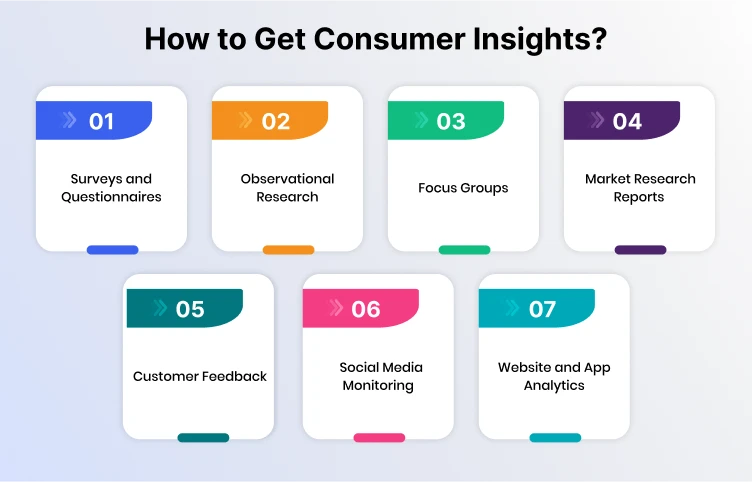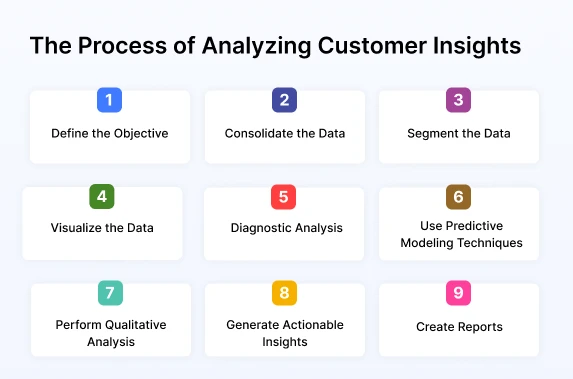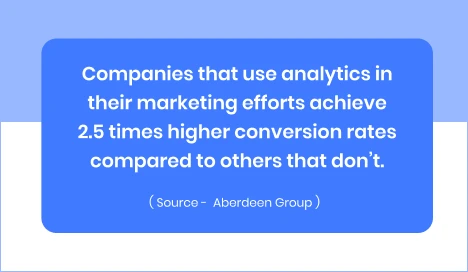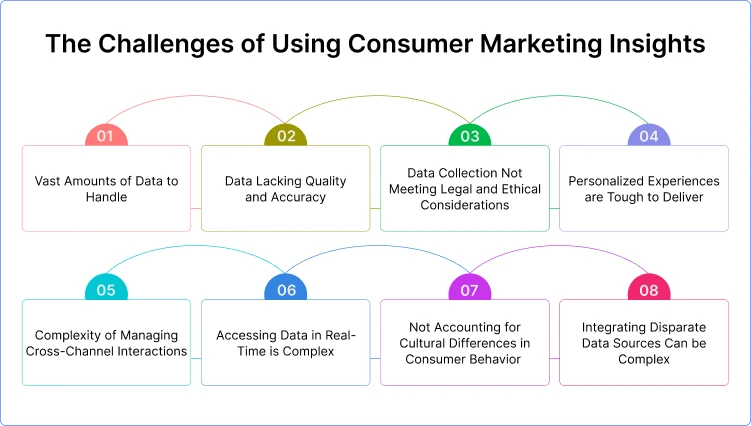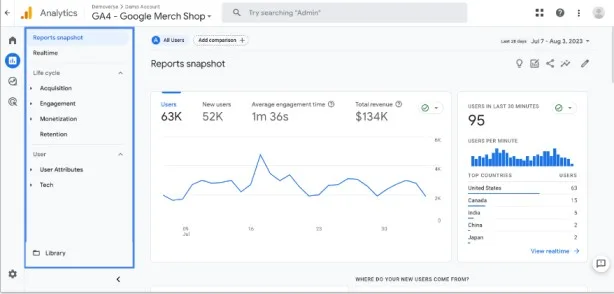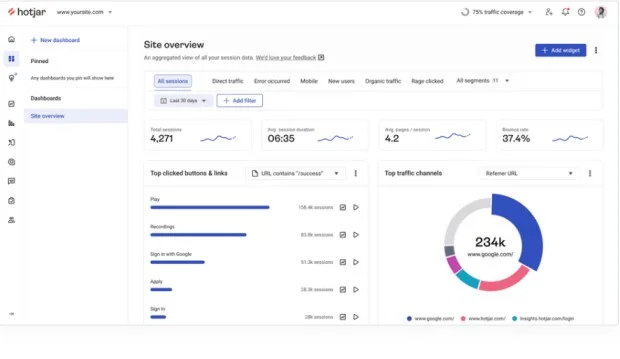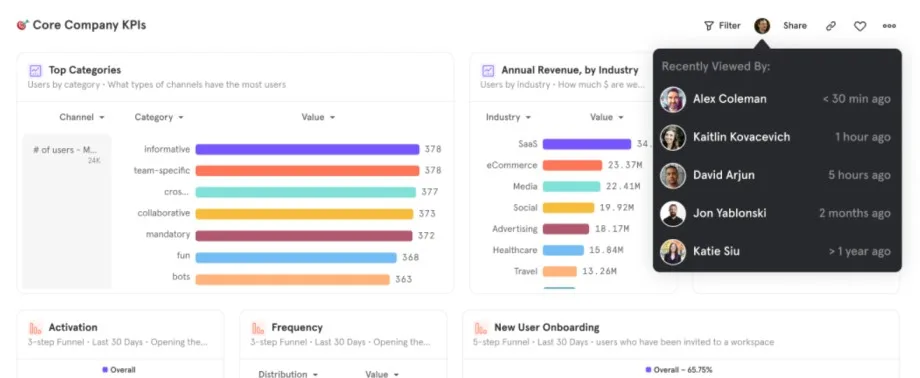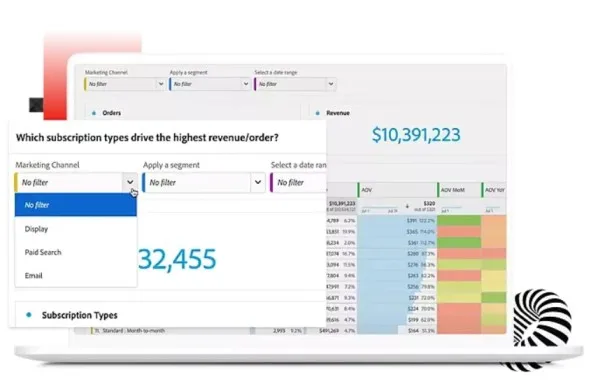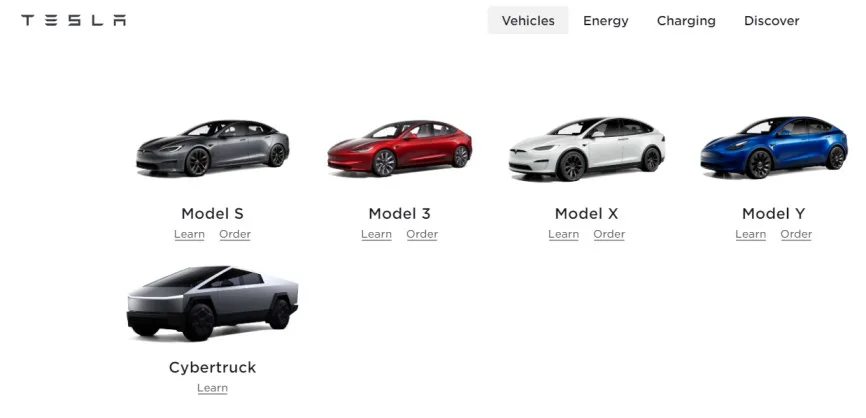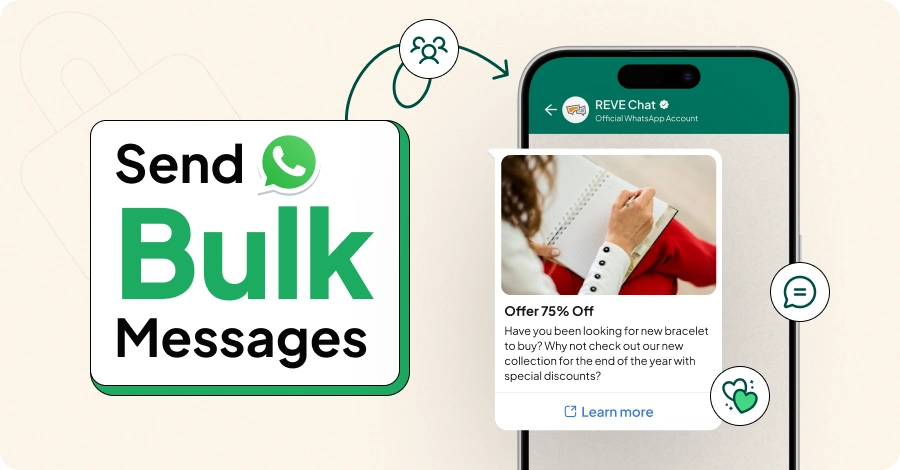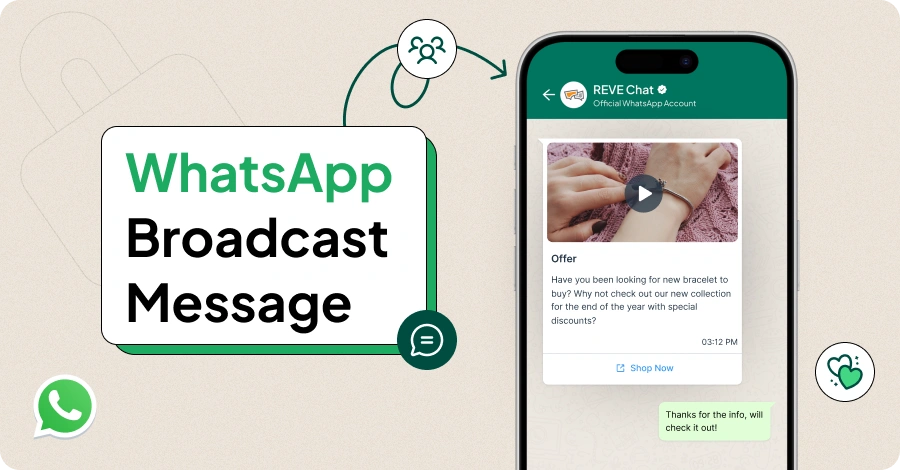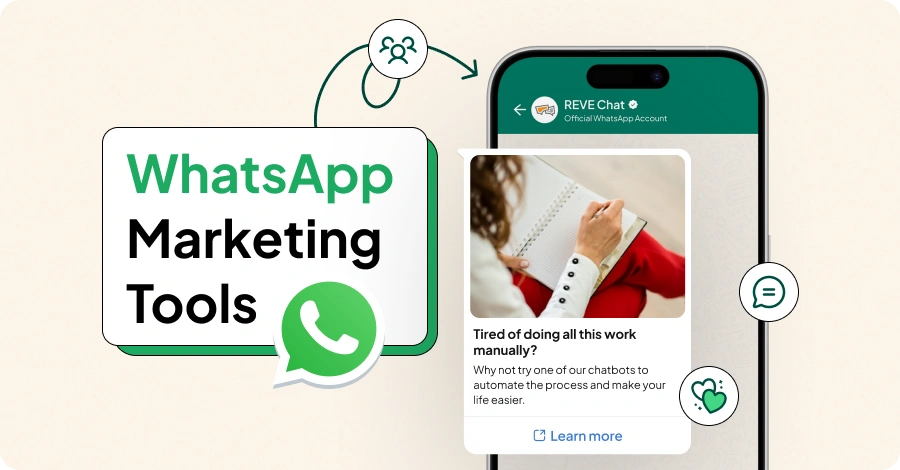What are Consumer Insights? Importance, Tools & Examples
- April 8, 2024
- 17 mins read
- Listen

Table of Content
Creating happy and loyal customers is never a matter of luck. It requires strategic planning and meticulous execution. Your business can also achieve this by meeting customers’ needs and giving them what they want. However, the key question is: how to meet your customer’s needs and wants? Well, you first need to understand what they need and only then can you deliver on that. This is where gathering consumer insights can help. After all, As per Salesforce Research, 63% of consumers expect businesses to know their unique needs and expectations.
Gathering customer insights means you need to listen to what people say about your business across channels be it on social media, online forums, or other digital platforms. It also means you need to analyze what consumers think about your business, what grievances they have, and what makes them stick with your business. All these insights are key to delivering value to your audience and winning their trust forever. They will help you serve your customers better at each stage of their journey with your brand.
In this blog, we will explore consumer marketing insights in detail, and understand its definition, importance, and benefits, together with the tools and examples.
Before moving further, let’s first get started with the definition of consumer insights…
What are Consumer Insights?
Consumer insights, or customer insights, can be defined as data-driven observations that businesses use to better understand their customers. These insights are key to making informed decisions about how to engage with the target audience more effectively.
Customer insights are gained when businesses interpret customer data, feedback, and behaviors into conclusions. Such interpretation can be used to drive actions aimed at improving product development and enhancing customer support.
Customer insights can also refer to:
- The actionable motivations behind the needs and wants of customers
- The tool to guide the development of new products and features
- The 360-degree customer view for driving the overall business operations
Consumer insights are crucial for understanding how and what customers think about the business. When used judiciously, these insights can provide answers to important questions, such as:
- What are the demographics of your customers?
- How do your customers perceive your brand?
- What motivates your customers to purchase?
- What channels do your customers prefer more for communication?
- What opinion do your customers have about a new product?
- How satisfied your customers are with existing products or services?
- How likely are your customers to leave?
- How loyal are your customers?
The Importance of Consumer Insights
A successful business often has a detailed understanding of its target audience’s behavior and preferences. It also knows what its customers want and need. This crucial information helps it exceed the expectations of consumers.
However, without these insights, any business might fail to develop products and services that resonate well with consumers, resulting in missed opportunities. A lack of customer data means a business might struggle and feel like operating in the dark. Consumer insights can mitigate all these risks.
Customer insights have a huge significance for many reasons, including –
- Data-driven decisions – Using audience insights means the actions and decisions a business takes are rooted in data. Such decisions will always align with the business goals and market demand since they are made based on a deep knowledge of customer motivations, pain points, and preferences.
- Lower risk elements – Customer feedback and opinions often form the basis of insights that businesses use to make varied strategic decisions. Since these insights are a reflection of what customers think, they help minimize the risk elements linked with various key decisions, be it product development or market expansion.
- Personalized approach to engagement – Customers feel more engaged when businesses use a personalized approach to cater to their preferences. They are more receptive to messages, products, and services tailored to their specific needs.
- Higher return on investment (ROI) – When you have the insights, you can guide your marketing efforts in the right direction, control wasted resources, and also minimize the risks of ineffective campaigns. These insights are essential to drive innovation and achieve sustainable growth, resulting in higher ROI.
- Meeting customer expectations more frequently – A business that uses data is more likely to meet customer expectations at each stage of the journey. It will also better understand the “what, when, and how” of customers’ wants.
- Improved customer loyalty and satisfaction – Using key customer insight, your business will better meet consumer demands, resulting in improved loyalty and satisfaction. It will also help the business in forging meaningful relationships with consumers.
Types of Consumer Insights
Consumer insights offer a detailed peek into what customers think about a business and what they want. They provide valuable information for understanding the target audience and developing result-driven strategies. Since these insights come in different types, getting diverse opinions on consumers becomes easy.
Customer insights can be categorized into six main types –
1. Behavioral Insights
These insights provide data related to the behaviors, actions, and purchasing patterns of consumers. The main focus area of behavioral insights is on what consumers do rather than what they say.
2. Attitudinal Insights
These insights examine the attitudes, opinions, perceptions, and beliefs of consumers about things related to the business, be it products, services, the brand, or more. The focus area of attitudinal insights is more on the motivations and values of customers.
3. Demographic Insights
These insights examine various demographic factors such as age, gender, occupation, location, income, education, and more. Using demographic insights is key to segmenting the audience effectively and delivering messages accurately to specific groups.
4. Psychographic Insights
These insights delve into the lifestyles, personalities, aspirations, and hobbies of consumers. Using psychographic insights, a business can personalize its messaging and offering to align with the audience’s preferences.
5. Emotional Insights
These insights analyze the emotional reactions and responses of consumers towards offerings from the business. The focus area of emotional insights is to examine the emotions driving consumer behavior.
6. Purchase Journey Insights
These insights map the various stages involved in a customer journey. It helps in a better understanding of the touchpoints, interactions, and channels, and how consumers react to them.
Key Stats on Benefits of Using Consumer Insights
More businesses use the power of insights to align their offers to the specific needs of the target audience. Consumer insights are being used across industries and your business can also benefit from it and serve customers better.
Here are the key stats on customer insights –
- Organizations that use consumer insights – and prioritize customer experience – are 60% more likely to have higher customer satisfaction rates compared to their competitors. ( Source – Deloitte )
- Businesses that use customer data in their marketing strategies achieve an average of 10% higher conversion rates. ( Source – Adobe )
- Brands that integrate consumer insights into their decision-making processes are 33% more likely to gain market leadership within their industry. ( Source – McKinsey & Company )
- Companies that use analytics in their marketing efforts achieve 2.5 times higher conversion rates compared to others that don’t. ( Source – Aberdeen Group )
How to Get Consumer Insights?
Collecting or gathering customer insights is vital for businesses to understand their audience and their needs more accurately. Several methods are available that can be used to gather deep insights into customers’ behaviors and preferences.
Let’s look at some of the major ways to get consumer insights –
1. Surveys and Questionnaires
Surveys and questionnaires are among the best ways to gather information directly from users. You can run surveys online, through the mail, or in person, and frame relevant questions about the experiences and preferences of your audience.
2. Observational Research
This type of research is very helpful when you want to observe consumers in real-life settings. You can use observational research to understand how customers interact or behave with your offers, or how they feel about your products or services.
3. Focus Groups
Focus groups are very helpful for getting insights through interactive discussions. In this, you arrange a small group of buyers together and encourage them to discuss your products or services in detail. This helps you gauge customer preferences and perceptions.
4. Market Research Reports
Analyzing and studying the industry or market is always a great way to get consumer insights. You can also use market research reports to understand broader trends in consumer behavior and preferences within a specific market.
5. Customer Feedback
Feedback collection is one of the easiest ways to gain insights into customer satisfaction levels. You can ask consumers to share feedback through the channels of choice be it online reviews, forms, or support interactions. Analyzing the feedback will help you know the areas to improve.
6. Social Media Monitoring
A lot of users go to special media to share views and opinions about products, services, or brands. They leave comments, reviews, and mentions which businesses can use to get insights into their sentiment and preferences.
7. Website and App Analytics
Your website or mobile app is an excellent source to understand what consumers think about your business. You can also use the site and app to track key metrics such as conversion rates, and page views, and gain a deep knowledge of their preferences and behavior.
The Process of Analyzing Customer Insights
Analysis of customer insights is key to extracting meaningful information from the data. However, you need to follow a systematic process if you want to derive actionable insights from the customer data you have collected.
Here is a step-by-step process for analyzing customer insights –
Step 1 – Define the Objective
Defining the objectives is the first step when you aim to analyze customer insights. Identify the key metrics or KPIs you need to measure.
Step 2 – Consolidate the Data
The customer data you have collected needs to be consolidated into a single repository for analysis. You also need to clean and organize the data to maintain consistency and accuracy.
Step 3 – Segment the Data
All the data you have consolidated needs to be segmented based on relevant criteria. After that, you need to analyze each customer segment separately to identify the patterns.
Step 4 – Visualize the Data
Visualizing the data will help you perform a descriptive analysis using charts, graphs, and tables. When the data is summarized and visualized, it gives elaborate insights into consumer behavior.
Step 5 – Diagnostic Analysis
Performing a diagnostic analysis of the data will help you understand the correlations and causations between different variables.
Step 6 – Use Predictive Modeling Techniques
You need to leverage predictive methods to forecast outcomes and future trends. Developing predictive models is key to using historical data and anticipating risks and opportunities.
Step 7 – Perform Qualitative Analysis
All the qualitative data you have gathered from customer feedback needs to be evaluated to gain deeper insights into customer motivations, emotions, and perceptions.
Step 8 – Generate Actionable Insights
Now that all the analyses are done, you reach the stage of synthesizing the findings. This is done to generate actionable insights specific to your business objectives. It will help you identify the challenges and implications for the business.
Step 9. Create Reports
Creating reports is the last step where you need to present the insights clearly. It will help you present complex information in a more easy-to-understand form.
Why Use Consumer Insights in Marketing?
Marketing strategies can prove ineffective when they are created without considering customer needs and wants. They however have more impact when based on consumer insights. Maybe that’s why marketers leverage data and analytics more as it helps them serve customers better.
There are many reasons for using consumer insights in marketing –
- To understand customer needs better and serve them more effectively
- To know what drives consumers to make specific purchasing decisions
- To create targeted marketing campaigns with more relevant messaging and communication
- To achieve higher engagement and conversion rates
- To create personalized experiences for customers based on the various stages of their journey with the brand
- To complement product development and ensure value-added features to consumers
- To achieve innovation in product and services
- To achieve higher levels of customer satisfaction and loyalty
- To allocate marketing budget and resources tactically and in alignment with the importance of each channel
- To evaluate the effectiveness of each marketing channel before devising a customer engagement strategy
- To optimize marketing spend and achieve higher ROI and better results
- To keep track of emerging trends and changes in consumer behavior
The Challenges of Using Consumer Marketing Insights
Marketers often leverage consumer insights to develop targeted and personalized communication strategies. They rely heavily on customer data to create an impact through marketing strategies. However, maximizing the value of customer insights in marketing is not easy and it can be challenging for various reasons.
Discussed below are the challenges of using consumer insights in marketing –
1. Vast Amounts of Data to Handle
Marketers today have tons of customer data available from various sources such as social media, website analytics, apps, and feedback. The data overload makes it difficult to identify actionable insights.
2. Data Lacking Quality and Accuracy
Quality and accuracy are two of the biggest issues with the data available today for marketing purposes. The data may have errors, or it may be outdated or incomplete, resulting in wasted marketing strategies and efforts.
3. Data Collection Not Meeting Legal and Ethical Considerations
Consumers show a lot of privacy concerns with the way their data is gathered and analyzed by marketers. There is no surety whether the data, or the method of collection, complies with the standard regulations, or whether it follows all the legal and ethical considerations.
4. Personalized Experiences are Tough to Deliver
Customers love personalized experiences as it helps them connect more with the business. However, such experiences can only be delivered when there is proper segmentation of the audience. Marketers often have a tough time identifying meaningful segments, so they fail to offer personalized touches to communication.
5. Complexity of Managing Cross-Channel Interactions
Customers engage with businesses across channels. They also enjoy the freedom of using the channel of choice for engagement. In all this, marketers may find it tough to determine how much each customer touchpoint contributes to conversion. Using data integration and advanced analytics techniques can help avoid this problem.
6. Accessing Data in Real-Time is Complex
Marketing campaigns are best optimized when real-time customer data is available. However, accessing data in real time can be complex due to the limitations that most businesses face in data processing capabilities.
7. Not Accounting for Cultural Differences in Consumer Behavior
Marketing campaigns can prove ineffective when cultural and contextual differences in consumer insights are not accounted for. After all, the way consumer behaves and shows preferences may vary across different geographies and demographics.
8. Integrating Disparate Data Sources Can be Complex
Marketers rely on various sources for data. However, they don’t focus on integrating those disparate sources as it takes time. Not integrating the data can prevent from having a comprehensive view of the consumer.
Popular Tools for Consumer Insights Analytics
When it comes to consumer insights, there are several analytics tools available that businesses can leverage and understand consumers better. These tools can give a deep insight into customer preferences and behavior, resulting in the success of marketing strategies.
Here are some of the top-rated consumer insights analytics tools for your business –
1. Google Analytics
Your business can use the various features and functionalities of Google Analytics to get rich customer insights. It helps you track and report website traffic in real time. This tool is very helpful for analyzing key shifts in consumer engagement and behavior with your business.
Key Features
- Analyze how users interact with your website
- Track various customer engagement metrics
- Map the customer journey phases
- Segment your website data in different categories
2. Hotjar
It is a powerful product experience insights platform to understand consumer behavior regarding the use of your website or digital product. Hotjar gives you access to qualitative and quantitative data and also helps in tracking the way users engage with your site or product.
Key Features
- Get a comprehensive view of user metrics
- Understand user behavior through heatmaps, and session recordings
- Visualize how users navigate your website and make data-driven decisions
3. Mixpanel
If you are looking for a product analytics tool, Mixpanel is surely the best in the category. It will give you insights about the top features of your products and also about the customer journey. You can rely on it for predicting product adoption among segments.
Key Features
- Learn about customers through interactive reports
- Find and track key trends with engagement reporting and analysis
- Segment customer journeys and optimize the user experience
4. Adobe Analytics
Adobe Analytics is the tool when you want to analyze customer data across multiple channels. It’s an advanced analytics platform offering robust reporting and visualization capabilities. By using this tool, you can get deep insights into consumer behavior.
Key Features
- Track and measure customer interactions
- Get actionable insights from consumer data
- Understand audience demographics and interests
Consumer Insights Examples
Consumer insights are important when it comes to making informed decisions about products, services, and strategies. Brands are using those insights to serve customers better and gain a competitive edge in the market.
Let’s look at some real-life examples from the industry showing the use of consumer insights –
1. Coca-Cola Using Consumer Insights to Offer Healthier Choices
Consumers are increasingly becoming health-conscious with more focus on using only healthier food options. The rise of various diet-related health issues largely drives this shift. Coca-Cola has leveraged market insights to recognize the changing attitude in consumer preferences towards healthier choices. They have introduced products like Diet Coke with low or no-sugar options.
2. Oatly Realizes Changing Consumer Preferences and Offers Oat-Based Dairy Alternatives
Consumers now prefer dairy products that are lower in sugar compared to the available options in the market. This need is fuelled by health-conscious people who no longer want to use traditional dairy options. Oatly is a popular brand that has recognized the changing shift in consumer behavior, so it offers oat-based dairy alternatives, including oat milk, that have lower sugar.
3. The Ordinary Caters to Consumers with Science-Backed Skincare Products
Consumers seek effective and affordable skincare options. They want the products to come with simple formulations and transparent labeling. Above all, the need for science-backed products is growing among health-conscious people. The Ordinary is a brand that effectively taps into the changing consumer needs by using the power of market insights and offers high-quality products without needless additives.
4. Tesla Addressing Consumer Insight to Cater Eco-Conscious Buyers
The automotive industry is witnessing a growing demand for sustainable vehicles. More consumers now prefer environmentally friendly cars that combine the best of style and tech prowess. Tesla works on these consumer insights by offering a line of electric vehicles (EVs). its products are among the most popular in the industry, redefining the way mobility is done and making it a leader in the EV market.
Boost Engagement with REVE Tools and Gain Consumer Insights
It takes engagement to understand what your customers think about your business and your offers. The more you engage, the better consumer insights you can gain.
At REVE Chat, we realize the huge value that effective engagement brings to a business and that’s why we offer a suite of tools to help you engage like never before.
You can use our AI-powered chatbot to speed up customer responses and automate tasks across marketing, sales, and support.
We also have video chat software and co-browsing software that can enhance the visual level of engagement.
Our bot can be added to the live chat software to deliver hybrid responses and ensure superior customer experiences.
Final Thoughts
The role of consumer insights is unquestionable when it comes to understanding your audience better. More businesses now rely on those insights to achieve innovation with their products and services.
With REVE Chat, you can find the tools and technology to enhance the levels of engagement with your users and gain deeper insights about them.
So, you can sign up and check how our products can add value to your business on different levels.

